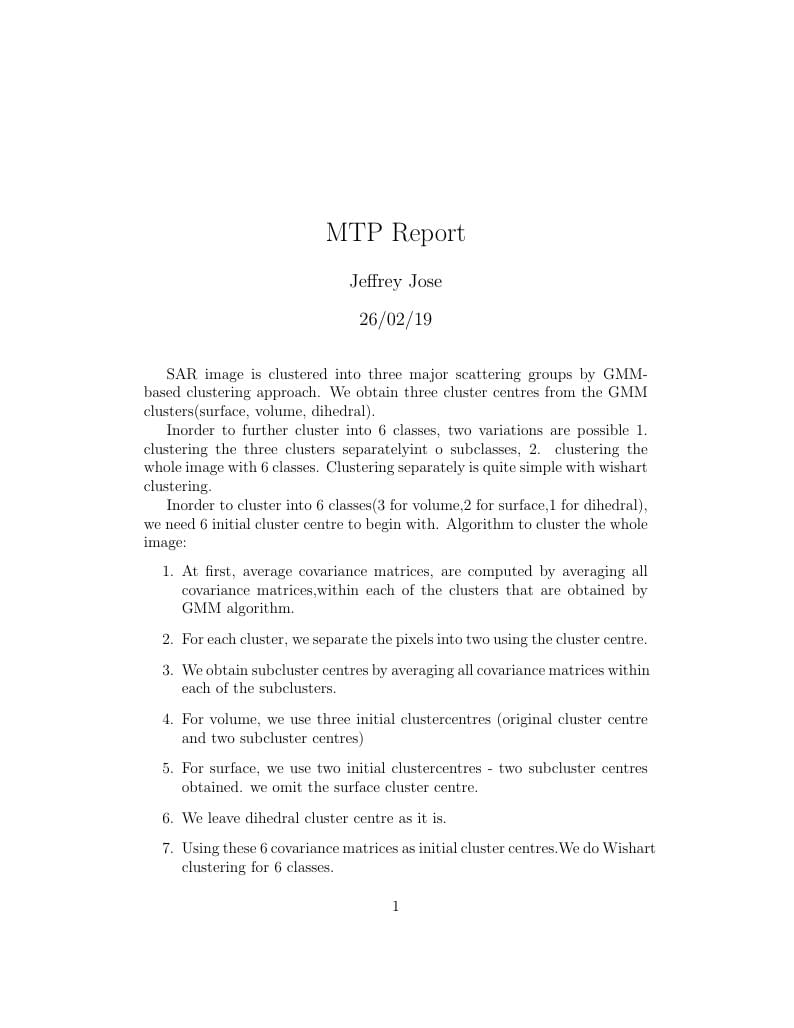
MTP report
Author:
Jeffrey Jose
Last Updated:
7 years ago
License:
Creative Commons CC BY 4.0
Abstract:
SAR image clustering

\begin
Discover why over 20 million people worldwide trust Overleaf with their work.
SAR image clustering

\begin
Discover why over 20 million people worldwide trust Overleaf with their work.
\documentclass[12pt]{article}
\usepackage{amsmath}
\usepackage{graphicx}
\usepackage{hyperref}
\usepackage[latin1]{inputenc}
\title{MTP Report}
\author{Jeffrey Jose}
\date{26/02/19}
\begin{document}
\maketitle
SAR image is clustered into three major scattering groups by GMM-based clustering
approach.
We obtain three cluster centres from the GMM clusters(surface, volume, dihedral).
\par
Inorder to further cluster into 6 classes, two variations are possible 1. clustering the three clusters separatelyint o subclasses, 2. clustering the whole image with 6 classes. Clustering separately is quite simple with wishart clustering.\par
Inorder to cluster into 6 classes(3 for volume,2 for surface,1 for dihedral), we need 6 initial cluster centre to begin with.
Algorithm to cluster the whole image:
\begin{enumerate}
\item At first, average covariance matrices, are computed by averaging all covariance matrices,within each of the clusters that are obtained by GMM
algorithm.
\item For each cluster, we separate the pixels into two using the cluster centre.
\item We obtain subcluster centres by averaging all covariance matrices
within each of the subclusters.
\item For volume, we use three initial clustercentres (original cluster centre and two subcluster centres)
\item For surface, we use two initial clustercentres - two subcluster centres obtained. we omit the surface cluster centre.
\item We leave dihedral cluster centre as it is.
\item Using these 6 covariance matrices as initial cluster centres.We do Wishart clustering for 6 classes.
\item We compute a distance between every pixel to these 6 initial cluster
representatives. The distance measure for cluster assignment of every pixel is derived from Wishart distribution.
\item Each pixel is assigned (re-assigned) to a cluster, whose representative centre is at the minimum distance from the pixel. This step can be iterated till some stopping criterion is met.
\end{enumerate}
Instead of using GMM clusters, we can use wishart refined clusters (doing wishart clustering for 3 classes on the GMM output). After obtaining the refined three clusters we can continue to cluster them into 6 classes using the above mentioned algorithm.\par
A total of 4 variations are possible,
\begin{enumerate}
\item using GMM clusters directly, clustering using wishart clustering , on the whole image with 6 initial cluster centres.
\item using GMM clusters directly, clustering using wishart clustering , on the 3 clusters separately.
\item using wishart refined clusters, clustering using wishart clustering , on the whole image with 6 initial cluster centres.
\item using wishart refined clusters, clustering using wishart clustering , on the 3 clusters separately.
\end{enumerate}
\begin{figure}
\includegraphics[width=\linewidth]{boat.png}
\caption{Clustered image of Kharagpur region.}
\label{fig:boat1}
\end{figure}
Figure \ref{fig:boat1} Clustered image of Kharagpur region.
\end{document}